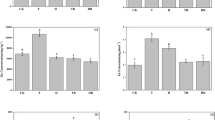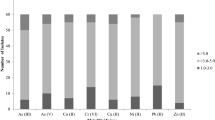Abstract
The macrofungus, Tricholoma lobynsis, was chosen to remedy Zn–Cd–Pb contaminated soil. To enhance its metal-extracting efficiency, two heavy metal resistant microbes M6 and K1 were applied owing to their excellent abilities to solubilize heavy metal salts. The two isolated microbial strains could also produce indole acetic acid (IAA), siderophore and solubilize inorganic phosphate, but neither of them showed 1-aminocyclopropane-1-carboxylate deaminase activity. The strains M6 and K1 were identified as Serratia marcescens and Rhodotorula mucilaginosa based on 16S rDNA and ITS sequence analysis respectively. Pot experiment showed that spraying to T. lobynsis-inoculated soil with M6 and K1 respectively could increase total Cd accumulations of this mushroom by 216 and 61%, and Zn by 153 and 49% compared to the uninoculated control. Pb accumulation however, was too low (<1 mg kg−1) to be determined. The results illustrated that special microbes and macrofungi can work together to remedy polluted soil as plant and plant growth promoting microbes do, probably because of excellent metal-accumulating abilities of macrofungi and IAA-siderophore production, phosphate solubilization abilities of the assisted-microbes. This kind of macrofungi-microbe interaction can be developed into a novel bioremediation strategy.


Similar content being viewed by others
References
Aleem A, Isar J, Malik A (2003) Impact of long-term application of industrial wastewater on the emergence of resistance traits in Azotobacter chroococcum isolated from rhizospheric soil. Bioresour Technol 86:7–13
Altschul SF, Madden TL, Schäffer AA, Zhang J, Zhang Z, Miller W, Lipman DJ (1997) Gapped BLAST and PSI-BLAST: a new generation of protein database search programs. Nucleic Acids Res 25:3389–3402
Baker AJM, McGrath SP, Reeves RD, Smith JAC (2000) Metal hyperaccumulator plants: a review of the ecology and physiology of a biological resource for phytoremediation of metal-polluted soils. Lewis Publisher, Boca Raton
Byers HK, Stackebrandt E, Hayward C, Blackall LL (1998) Molecular investigation of a microbial mat associated with the Great Artesian Basin. FEMS Microbiol Ecol 25:391–403
Cho YS, Kim JS, Crowley DE, Cho BG (2003) Growth promotion of the edible fungus Pleurotus ostreatus by fluorescent pseudomonads. FEMS Microbiol Lett 218:271–276
Dell’Amico E, Cavalca L, Andreoni V (2008) Improvement of Brassica napus growth under cadmium stress by cadmium-resistant rhizobacteria. Soil Biol Biochem 40:74–84
Demirbas A (2002) Metal ion uptake by mushrooms from natural and artificially enriched soils. Food Chem 78:89–93
Guo X, Zou X, Sun M (2009) Effects of phytohormones on mycelial growth and exopolysaccharide biosynthesis of medicinal mushroom Pellinus linteus. Bioprocess Biosyst Eng 32:701–707
Han J (1999) The influence of photosynthetic bacteria treatments on the crop yield, dry matter content, and protein content of the mushroom Agaricus bisporus. Sci Hortic 82:171–178
Jiang C-y, Sheng X-f, Qian M, Wang Q-y (2008) Isolation and characterization of a heavy metal-resistant Burkholderia sp. from heavy metal-contaminated paddy field soil and its potential in promoting plant growth and heavy metal accumulation in metal-polluted soil. Chemosphere 72:157–164
John MB, Richard MB, Sara ES (1991) Rapid in situ assay for indole acetic acid production by bacteria immobilization on a nitrocellulose membrane. Appl Environ Microbiol 57:535–538
Kalac P, Svoboda L (2000) A review of trace element concentrations in edible mushrooms. Food Chem 69:273–281
Khan AG (2005) Role of soil microbes in the rhizospheres of plants growing on trace metal contaminated soils in phytoremediation. J Trace Elem Med Biol 18:355–364
Kumar KV, Srivastava S, Singh N, Behl HM (2009) Role of metal resistant plant growth promoting bacteria in ameliorating fly ash to the growth of Brassica juncea. J Hazard Mater 170:51–57
Lebeau T, Braud A, Jézéquel K (2008) Performance of bioaugmentation-assisted phytoextraction applied to metal contaminated soils: a review. Environ Pollut 153:497–522
Leyval C, Turnau K, Haselwandter K (1997) Effect of heavy metal pollution on mycorrhizal colonization and function: physiological, ecological and applied aspects. Mycorrhiza 7:139–153
Lindsay WL, Norvell WA (1978) Development of a DTPA soil test for zinc, iron, manganese, and copper1. Soil Sci Soc Am J 42:421–428
Liukkonen-Lilja H, Kuusi T, Laaksovirta K, Lodenius M, Piepponen S (1983) The effect of lead processing works on the lead, cadmium and mercury contents of fungi. Zeitschrift für Lebensmitteluntersuchung und -Forschung A 176:120–123
Ma Y, Rajkumar M, Freitas H (2009) Isolation and characterization of Ni mobilizing PGPB from serpentine soils and their potential in promoting plant growth and Ni accumulation by Brassica spp. Chemosphere 75:719–725
Mendil D, Uluözlü ÖD, Tüzen M, Hasdemir E, SarI H (2005) Trace metal levels in mushroom samples from Ordu, Turkey. Food Chem 91:463–467
O’Donnell K (1992) Ribosomal DNA internal transcribed spacers are highly divergent in the phytopathogenic ascomycete Fusarium sambucinum (Gibberella pulicaris). Curr Genet 22:213–220
Paul N, Sundara Rao W (1971) Phosphate-dissolving bacteria in the rhizosphere of some cultivated legumes. Plant Soil 35:127–132
Pletsch M, de Araujo BS, Charlwood BV (1999) Novel biotechnological approaches in environmental remediation research. Biotechnol Adv 17:679–687
Rajkumar M, Freitas H (2008a) Effects of inoculation of plant-growth promoting bacteria on Ni uptake by Indian mustard. Bioresour Technol 99:3491–3498
Rajkumar M, Freitas H (2008b) Influence of metal resistant-plant growth-promoting bacteria on the growth of Ricinus communis in soil contaminated with heavy metals. Chemosphere 71:834–842
Rajkumar M, Ae N, Prasad MNV, Freitas H (2010) Potential of siderophore-producing bacteria for improving heavy metal phytoextraction. Trends Biotechnol 28:142–149
Schwyn B, Neilands JB (1987) Universal chemical assay for the detection and determination of siderophores. Anal Biochem 160:47–56
Sheng X-F, Xia J–J (2006) Improvement of rape (Brassica napus) plant growth and cadmium uptake by cadmium-resistant bacteria. Chemosphere 64:1036–1042
Sheng X, He L, Wang Q, Ye H, Jiang C (2008) Effects of inoculation of biosurfactant-producing Bacillus sp. J119 on plant growth and cadmium uptake in a cadmium-amended soil. J Hazard Mater 155:17–22
Thomet U, Vogel E, Krähenbühl U (1999) The uptake of cadmium and zinc by mycelia and their accumulation in mycelia and fruiting bodies of edible mushrooms. Eur Food Res Technol 209:317–324
Tiwari S, Kumari B, Singh SN (2008) Evaluation of metal mobility/immobility in fly ash induced by bacterial strains isolated from the rhizospheric zone of Typha latifolia growing on fly ash dumps. Bioresour Technol 99:1305–1310
Vivas A, Biró B, Németh T, Barea JM, Azcón R (2006) Nickel-tolerant Brevibacillus brevis and arbuscular mycorrhizal fungus can reduce metal acquisition and nickel toxicity effects in plant growing in nickel supplemented soil. Soil Biol Biochem 38:2694–2704
Weyens N, van der Lelie D, Taghavi S, Newman L, Vangronsveld J (2009) Exploiting plant-microbe partnerships to improve biomass production and remediation. Trends Biotechnol 27:591–598
White TJ, Bruns T, Lee S, Taylor J (1990) Amplification and direct sequencing of fungal ribosomal RNA genes for phylogeneties. In: Innis MA, Gelfand DH, Sninsky JJ, White JW (eds) PCR protocols. A guide to methods and applications. Academic press, New York, pp 315–322
Acknowledgments
We acknowledge financial support from the National High Technology Research and Development Program of China (863 Program), Project No. 2006AA06Z361 and appreciate special aid from Longquanyi Science and Technology Burea, Chengdu.
Author information
Authors and Affiliations
Corresponding author
Rights and permissions
About this article
Cite this article
Ji, Ly., Zhang, Ww., Yu, D. et al. Effect of heavy metal-solubilizing microorganisms on zinc and cadmium extractions from heavy metal contaminated soil with Tricholoma lobynsis . World J Microbiol Biotechnol 28, 293–301 (2012). https://doi.org/10.1007/s11274-011-0819-y
Received:
Accepted:
Published:
Issue Date:
DOI: https://doi.org/10.1007/s11274-011-0819-y




